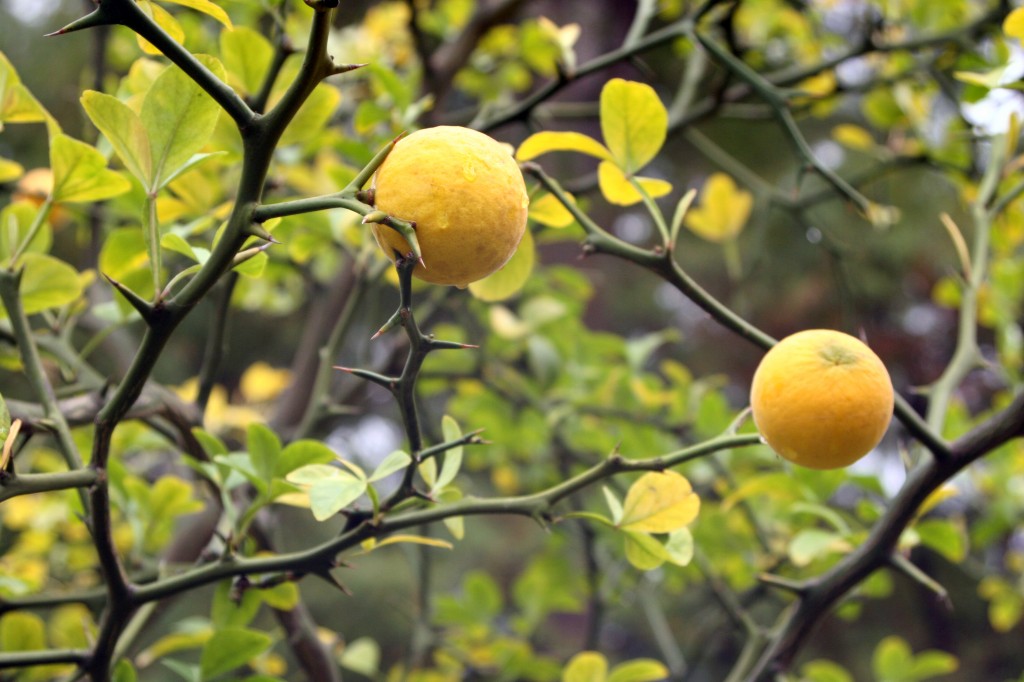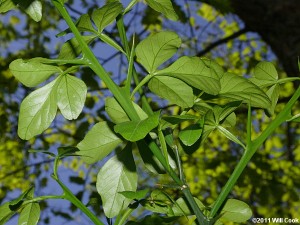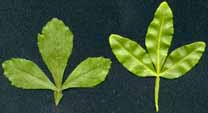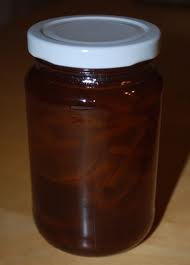
Hardy Orange, sometimes in the citrus clan, sometimes not. Photo by Aubree Cherie
Is the Hardy Orange edible? That depends on how hungry you are, or which century you live in.
A native of China, Hardy Orange (Poncirus trifoliata) aka Trifoliate Orange, was once grown in northern Europe where the fruit rind was candied and dried. As a cold-hardy pseudo- citrus American colonists also grew the Hardy Orange because the fuzzy fruit has pectin which was used in making jams and jellies. The fruit, minus, seeds, was also made into a not-sweet marmalade. In China the bitter fruits were used as seasoning (dried and powdered) and young leaves are occasionally boiled and eaten. Fresh fruit allowed to sit for two weeks after picking yields about 20% juice which can be diluted and made into a drink. The flavor is a cross between lemon and grapefruit. A slice of it is good in a gin-and-tonic. Do note that processing leaves a hard-to-wash off resin on utensils. The University of North Carolina, which I think believes every plant is toxic, lists the Hardy Orange as “poisonous.” It says the fruit can cause “severe stomach pain and nausea, prolonged contact can cause skin irritation.” But it also says “causes only low toxicity if eaten, skin irritation minor, or lasting only for a few minutes.” The fruit may also have some anti-allergic activity. In Chinese medicine it has been used to treat typhoid, toothache, hemorrhoids, conjunctivitis, colds and itchy skin.
The Hardy Orange is naturalized in the United States from Pennsylvania south and west to northern Florida and eastern Texas. In recent times Poncirus trifoliata has been used primarily as root stock for citrus along with at least three developed cultivars: Barnes, Rubidioux, and Flying Dragon, the latter of which has curved thorns. Interestingly while the original species came with the colonists the Flying Dragon was introduced from Japan to the U.S. in 1915 by American botanist Walter Tennyson Swingle (1871-1952). Swingle’s first major job was not far from here in Eustis, Florida, in 1892. He and Dr. Herbert John Webber experimented with citrus and formed the basis of much of what is known about citrus. They created Tangelos including the Minneola and crossed the Poncirus trifoliata with Citrus sinensis to create the Citrange, common in many landscaped gardens. In 1943 Swingle wrote “The Botany of Citrus and Its Wild Relatives of the Orange Subfamily.” Webber, by the way, was no botanical slouch either. He wrote over 300 research papers and created many cotton species that are still used in the clothes you wear.
Like many thorn-ladened trees, birds select the Hardy Orange to make their nests in as the two-inch thorns dissuade predatory creatures. The tree can be used as a natural fence and have often been used to corral livestock. The thorns are sturdy enough to puncture a tire or use as a tooth pick. The wood is extremely is hard and dense, the bark striped with green, stems are triangular. Early spring flowers are popular with bees and butterflies. Deer don’t like it nor rabbits. The aromatic fruit, ripening in the fall, can also be dried and used in potpourri mix. Fall foilage is butter-yellow.
The Hardy Orange grows to about six feet (sometimes 20 feet!) and starts bearing around 12-years old. They are a common bonsai specimen. It loses its leaves in winter and can be grown in protected areas as far north as Canada. It has been cultivated in China for thousands of years and in Japan since the 8th century. As mentioned above it came to North America in colonial times and was introduced into Australia in the late 1800s. It is also commonly used in Argentina. Hardy Orange prefers low-lime soil.
The botanical name, Poncirus trifoliata, is said pon-SEER-us try-foh-lee-AY-tuh, some say pon-SIGH-russ. Poncirus is from French meaning a citron. Trifoliata means three leaves.
Green Deane Itemized Plant Profile: Hardy Orange
IDENTIFICATION: Poncirus trifoliata: Tree to 20 feet, leaves alternate, compound, three leaflets, 1 to 2 inches long, may be finely wavy toothed, thickened, petiole winged, shiny dark green, flowers white, cup-shaped, fragrant. Vicious thorns, small fruit. Self-fertile, propagate by planting fresh seeds from ripe fruit. If you are going to store the seeds keep them cool (35-40F for at least 30 days) then warm for 24 hours in warm water. Chilled seeds germinates in two weeks if kept around 70-80F, a month at 60-70F. Poncirus is a monotypic genus with the only member the trifoliata.
TIME OF YEAR: Flowers in early spring, fruit in late fall.
ENVIRONMENT: Not too picky about soil but does not like line-heavy soil, prefers full sun but can tolerate some shade. Likes moist soil but will not tolerated being water logged.
METHOD OF PREPARATION: Fruit as marmalade, dried as seasoning, juice diluted for a drink.
Hardy Orange Marmalade
Use 30 to 50 fruit depending upon their size. Wash well. Cut each one equatorially and twist the halves apart. Squeeze the pulp, seed and what juice there is into a bowl. Remove the seeds. This is helped by adding a little water. You can slice the peelings or leave them whole.
Add the peelings to a jar holding 2.5 cups of water and 1/8 teaspoon of baking soda. Bring to a boil and simmer for 10 minutes. Pour off about 2 cups of the water. Add the juice and pulp and simmer for 10 more minutes. Meanwhile put enough jars (lids and screw-caps) for eight cups of marmalade into a big pot of water and bring them to a boil. Continue to let them boil very gently until the marmalade is ready to can.
Measure 4 cups of sugar then take 1/4 cup of that sugar and mix it with one package of pectin in a small bowl. In the large bowl add enough water to the juice/pulp mixture to bring the volume to 5.5 cups and put it in a gallon pot for cooking. Add the sugar/pectin mixture from the small bowl and a 1/2 tablespoon of oil. Bring a full boil stirring constantly as it heats. Then add the rest of the sugar and heat this till it again reaches a full boil. Boil for one more minute only. Turn off the heat and quickly put the marmalade into the sterile jars. Fill each jar to within 1/4 inch of the top, wipe off any marmalade that touches the rim. Set the lid, tighten, then do the next jar. Sealed jars should keep for months.
If you want to reduce the bitterness of the peelings first you can parboil them in as many changes of water as you like until the water is not bitter or of a bitterness of your liking. Cooking will leave a resin on your utensils. Alcohol will remove it quickly.
Herb Blurb
Antianaphylactic activity of Poncirus trifoliata fruit extract.
Source
Department of Oriental Pharmacy, College of Pharmacy, Wonkwang University, Seoul, South Korea.
Abstract
The effect of an aqueous extract of Poncirus trifoliata (L.) Raf. (Rutaceae) fruits (PTFE) on compound 48/80-induced mortality associated with anaphylaxis was studied in rats. PTFE inhibited compound 48/80-induced anaphylaxis 100% with a dose of 1.6 mg/g body weight (BW) 1 h before or 5 min after injection of compound 48/80. PTFE inhibited compound 48/80-induced anaphylaxis almost 100% with doses above 0.4 mg/g BW intraperitoneally administered. PTFE (1-1000 micrograms/ml) also dose-dependently inhibited the histamine release induced by compound 48/80 (5 micrograms/ml) in rat peritoneal mast cells. The level of cAMP in peritoneal mast cells, when PTFE was added, increased transiently, and significantly increased 53-fold at 10 s compared with that of basal cells. Moreover, PTFE inhibited intracellular calcium release induced by compound 48/80. These results suggest that PTFE has antianaphylactic activity by stabilizing the peritoneal mast cell membrane.
Anti-Helicobacter pylori activity of the metabolites of poncirin from Poncirus trifoliata by human intestinal bacteria.
Source
College of Pharmacy, Kyung-Hee University, Seoul, Korea.
Abstract
Poncirin was isolated from water extract of the fruits of Poncirus trifoliata and metabolized by human intestinal bacteria. The inhibitory effect of poncirin and its metabolites by these bacteria on the growth of Helicobacter pylori (HP) was investigated. Among them, ponciretin (5,7-dihydroxy-4′-methoxyflavanone), the main metabolite most potently inhibited the growth of HP, with a minimum inhibitory concentration (MIC) of 10-20 microg/ml. However, poncirin and its metabolites except ponciretin did not inhibit the growth of HP, nor did they inhibit HP urease.
Anti-inflammatory effect of Poncirus trifoliata fruit through inhibition of NF-?B activation in mast cells
Abstract
Mast cell-mediated allergic inflammation is involved in many diseases such as asthma, sinusitis, and rheumatoid arthritis. Mast cells induce synthesis and production of pro-inflammatory cytokines including tumor necrosis factor (TNF)-? and interleukin (IL)-6 with immune regulatory properties. We investigated the effect of the fruits of Poncirus trifoliata (L.) Raf (Rutaceae) (FPT) on expression of pro-inflammatory cytokines by activated human mast cell line, HMC-1. FPT dose dependently decreased the gene expression and production of TNF-? and IL-6 on phorbol 12-myristate 13-acetate (PMA) and calcium ionophore A23187-stimulated HMC-1 cells. In addition, FPT attenuated PMA and A23187-induced activation of NF-?B indicated by inhibition of degradation of I?B?, nuclear translocation of NF-?B, NF-?B/DNA binding, and NF-?B-dependent gene reporter assay. Our in vitro studies provide evidence that FPT might contribute to the treatment of mast cell-derived allergic inflammatory diseases.
Poncirus trifoliata fruit induces apoptosis in human promyelocytic leukemia cells
Volume 340, Issues 1–2, February 2004, Pages 179–185
Abstract
Background: Substances inducing apoptosis have shown efficacy in the treatment of cancers. Poncirus trifoliata (L.) Raf. (Rutaceae) fruits (PTF) has been used for the treatment of various cancers among Korean Oriental Medical doctors. Methods: PTF-induced cytotoxicity of human leukemia HL-60 cells was monitored by the MTT assay. The apoptosis was determined by (a) apoptotic morphology in microscopy; (b) DNA fragmentation in electrophoresis and FACS analysis; and (c) activation of caspase-3 and poly-ADP-ribose polymerase (PARP) cleavage assay. Results: The cytotoxic activity of PTF in HL-60 cells was increased in a concentration- and time-dependent manner. PTF caused the cell shrinkage, cell membrane blebbing, apoptotic body and DNA fragmentation. PTF-induced apoptosis is accompanied by the activation of caspase-3 and the specific proteolytic cleavage of PARP. However, PTF did not show cytotoxicity in normal peripheral blood mononuclear cells. Conclusions: Our novel finding provides evidence that PTF could be a candidate as an anti-leukemic agent through apoptosis of cancer cells.







What an interesting fruit! I had never heard of it before this post. I wonder if it could be sourced from Australia?
This is a great post! I have a few trifoliates growing outside my front door, and they put out their first, very small, fruits this year. I look forward to eventually making marmalade with them.
I HAD one in Galveston,Tx. A Vietnamese lady loved them. She also liked green papaya, shredded in dishes
I’ve a large poncirus trifoliata (about 18′ in height, spreading 9′), probably approaching 40 years since it was planted by others, at the southeastern corner of my house. Formerly in full sun, it’s now shaded by a 35′ pecan tree.
Its thorns are indeed vicious, and I’ve bled from their punctures, so extracting them as “natural toothpicks” is quite appealing!
It continues to flower fragrantly in spring, despite the recent shade, but I’m hoping it will continue to fruit, now that I’ve read your marmalade recipe, though I’m somewhat concerned about potential side effects mentioned in the scientific studies.
For many Christmases, not knowing if they were too toxic to eat, we boiled them for the delightful aroma they diffused throughout our home, with minimal added spices, such as cinnamon. I look forward to attempting a marmalade, based on your guidelines in this post.
I am growing Poncirus Trifoliata this year in the greenhouse to use as rootstock for citrus. Although I may now try letting one or two grow just to see what fruit I get. Very good article.
I know I’m late here but… depending on whether or not you intend to grow said citrus in the greenhouse (and depending on your climate of course, there are a few places too cold outdoors even for Trifoliate Orange) it would probably be best NOT to grow the rootstock in the Greenhouse. That’s just conditioning the plants to a milder environment than what’s waiting outside.
The Poncirus trifoliate (Hardy Orange) is not as bad as people make it out to be. The marmalade is good, however when peeling your fruit, do not get the white (pith) part. I used a finer cheese grater and scrape the outsides. It was good marmalade.
Try the Lemonade version –
Ingredients:
30-40 hardy oranges
1 1/4 cup sugar
1 quart of water
Peel 5 fruit (don’t get the pith) and pour 2 tablespoons of sugar over the peels. Let this set 15 minutes to help draw oil from the peels. Mean while, cut your remaining fruits in half and squeeze and strain juice out. Save the seeds and pour a few tablespoons of water over them, this maximizes your flavor.
Boil 2 cups of water and pour 1 cup over the peels and sugar, let this mixture sit 10 minutes. Strain out the liquid and pour into your orange-aid. Add 1 cup of hot water into your remaining sugar and dissolve. Mix everything together and chill.
Its like a cross of lemonade and orangeade.
I live in Virginia Beach, VA I’m a big fan of cold hardy citrus and I’m a beekeeper too. Please try sweetening your citrus drink with honey instead of sugar. Satisfaction guaranteed. Thank you for the recipe.
My neighbor used to have bees. They LOVED my trifoliata. He said they were harvesting the resin year round!! To make propolis? I dont remember!
I do love this fruit! The problem, though, is that I was looking up something entirely different on the Dr. Oz website when I came across this info:
Bitter Orange
Taken in the hopes that it can boost weight loss or relieve allergies, $21 million worth of bitter orange was sold last year. However, it can cause heart attack, stroke or even death. Bitter orange contains a stimulant similar to ephedrine, banned by the FDA in 2004 after 2 people died and several suffered heart attacks or strokes. This was the first time the FDA banned an herbal supplement and bitter orange has many similar chemical properties.
I am thinking you can get to the bottom of this better than I can.
If you reach a conclusion, post a comment. Otherwise, you don’t need to post this comment. I know you will investigate this thoroughly. I am quite impressed by your website. Thanks!
Bitter Orange supplements are usually extracts from the peelings. Cooked pulp, as in jam, could be quite different. It has a long history of non-dangerous use when used as described. Supplementation is moving into the medicinal realm and beyond the scope of this edible plant site.
I grow these terrifyingly-thorny shrubs under my windows. I can drink the lemonade (often warmed as a tea) of a half a fruit a day without any stomach issues. I can get a bit of stomach upset if i try, say, 2 whole fruits in an evening. I am lazy, so microwave the skin and seeds, in the water as well. Maybe if I left out the skin and seeds, I’d have no stomach issues if i used 2 an evening? Will try it soon. They must be pruned frequently to get them to stay in a shrub shape. They really want to be a small floppy tree.
I have a huge one of these trees in my back yard its awesome. My Dad and I have been trying to figure out just what kind of fruit tree this was. Tried the lemonade recipe now that we know and it was delicious. Hope to make marmalade this year!
Do you know how the trifoliate orange is spread? What eats it besides people? If no animals like to eat the fruit, how has it become such a nuisance plant on farm land here in Black Belt Alabama? You wrote that it likes low lime soil (which doesn’t seem to fit with it surviving so well here in the Black Belt). Was it just spread by people using it as a hedge plant? Can you give me some answers to these puzzles? By the way, I also see it in almost every rural African American cemetery here, and am wondering if it has some symbolic appeal – perhaps its reminder of Christ’s crown of thorns, or its evergreen stem?
P.S. There is a Nov. 1906 Scientific American Supplement that says “the common variety” was introduced into the U.S. by William Saunders of the Dept.of Agric. in 1869.
It may be that the animal that originally ate the fruit no longer exists.
A good example of this is the osage orange, a barely-edible orange sized lumpy green fruit packed with bitter white latex, like a giant mulberry from Hell. Nothing alive today eats these godawful things, which makes sense as the only things that did eat them were giant Megatherium sloths that went extinct about 12000 years ago. The honey locust, a tree with long sweet seedpods and thorns that can puncture tires and be used as nails is in a similar situation.
My trifoliata has suddenly flowered for a second time this year. I have developing fruit and flowers at the same time. How can this happen. We make delicious marmalade every year and last year a very special liqueur soaking whole fruit in Spanish Brandy and sugar.
My poncirus trifoliata also flourished a second time ( late september 2015). I assume this is due to the very hot summer we were having this year.
I have lots of fruit this year.
If you have a good recipe I would be glad to hear about.
is making juice with a juicemaker and jellying a solution??
I hope to hear from you.
CB
if anyone can get any fresh poncirus trifoliata seeds please let me know Ediblelandscaping.sc@gmail.com
Don’t do it. They grow like crazy. We have several hundred acres of wooded land. Theses things have taken over. They grow fast and have giant thorns. You will regret it.
We just bought a 60 acre farm that is lousy with this evil plant. It will be my life’s work to eliminate it. Any advice?
I have one that I planted 25 years ago that has more seeds than you know what to do with. I also have saplings I can mail for free as well. let me know ill be happy send one or 2
I have just recently found out about this Awe Inspiring tree! After FINALLY identifying it, I can’t wait to have them on our land.
I believe it was love at first sight, and matured it can provide me with multiple, practical uses. If you still have some available I would absolutely adores I’m sad feelings I’ve gathered many of the fresh fruit so I have plenty of seeds thank you.
If you still have saplings I would love some to plant.
I would love as many saplings as you can give me to plant.
Would love to have a couple of saplings. I found some fruit on the ground at my local botanical gardens and squeezed the juice into my gin and tonic. It was awesome!
Email me if you can send some saplings do I can send you my address and pay you for the shipping. Hankeegs@yahoo.com
Hi. If you still have some seeds or saplings I would love to have one to see how it would do here in Colorado drina1015@gmail.com
Actually, it’s probably not UNC that you say “thinks every plant is poisonous”… rather, NC State University, which has an extensive agricultural program. This plant is regularly sold at their plant sales.
We raise dwarf citrus in our nursery and thus have been given some larva from the giant swallowtail butterfly. put a few on the large citrus trifoliates that grow in several spots in our gardens. Does anyone know if they will eat it.
are the unripe fruit okay to consume? i have some that are fruiting right now but they are yellow with a little green. the inside of the fruit is complacently yellow and it does not smell to bad
Hmmm. The info on Stroke makes me wonder if it has a coagulant property that could be exploited. I found ths growing just across the street and noticed the trash collector harvesting fruit from it this year. Fruit are ping-pong to tennis ball in size and fuzzy with small fields of tiny brown spots. My Wife likes the idea of slicing, drying & putting out as Pot Pourri. I am intrigued by the Marmalade recipe. If this does have coagular properties then it’s use in the treatment of certain cancers makes even more sense (cutting their blood supply is seen as an effective treatment for tumors).
I have used the juice of the fruit for treating allergies, and it’s quite effective. However… the particular cultivar I have produces a juice that’s bitter as gall. Of course, that’s also the reason it’s effective as the compounds responsible for the anti-allergy effect (including poncirin, naringin, and naringenin) are quite bitter.
When I have a summer of bad allergies, I wait both in eagerness and dread as they ripen toward October. Then I shake them from the bushes and as their fragrant scent reaches my nose my stomach begins heaving as it knows what I’m about to subject it to.
After 5 days of the nauseating treatment involving pinching my nose, choking the juice from 6 of the little things down as fast as I can and immediately washing my mouth out with hot water so not a trace of the taste remains, my allergies drastically subside and tend to remain mostly or completely gone for the rest of autumn, winter, and much of spring. It is able to directly suppress production of IgE antibodies, the type responsible for allergies, by an as-yet unknown mechanism.
Also, if you use it in this way, you will note that your intestines will be cleansed rather thoroughly by the end of the treatment. ;D
Hi, does anyone know if you can use the flowers of Citrus trifoliata in the same you can use the flowers of the other bitter orange (Citrus aurantium) to make orange blossom water and orange essential oil?
I might have an answer. Cornucopia II calls Citrus trifoliata Poncirus trifoliata (page 221.) There is says: “The rind of the fruit can be candied. In China, the bitter fruits are used for seasoning. When first picked the fruit gives very little juice when pressed but after being kept for two weeks they yield about twenty percent juice. A drink can be made from the diluted juice. Young leaves are occasionally boiled and eaten.”
Hi, thanks for the reply. Im particularly interested to know if the flowers can be used though. The Seville bitter orange flowers are a big commercialsource source for making orange essential oil and orange blossom water so I was wondered if poncirus trifoliata flowers can be used in the same way
I have no reference to the flowers.
Hi, does anyone know the citric acid content of poncirus trifoliata?
According to one scientific article 352.5 mg/L ascorbic acid….
↑ https://kundoc.com/pdf-poncirus-trifoliata-l-raf-chemical-composition-antioxidant-properties-and-hypogl.htm
We have a beautiful hedge of Poncirus trifoliata in our park. You mention in your blog that the colonists brought this plant to America. Do you have a reference?
It is native to China and the Korean Peninsula. It was used by early American colonists. Someone had to bring it here.
https://naturewalk.yale.edu/trees/rutaceae/poncirus-trifoliata/trifoliate-orangehardy-orange-3
We have a great patch of trifoliate orange near Saxapahaw and I plan to take my students there to harvest. Thanks for the info. By the way I went to UNC and they do believe every plant is poisonous. It’s a conservative environmentalism that does not recognize our true connection to nature…keep on foraging, it’s stewardship.
When I still had my farm i had literally hundreds of these plants. Every fall I would gather the fruit and put them in bowls and set them around the house. At the time I didn’t know I could have been ingesting them in so many ways! I now have access to a few of these wonderful plants at a small garden at Randolph College, down the street. Thank you for this informative article!
I love this citrus tree/bush. I live in Texas near a river. I accidentally found some mature wild tri-foliate growing along the river. An active logging road was whwere i walked in the evenings and found a thorny limb on the path. My Dad told me those large thorns (needle like) are from a wild citrus. It turned out to be trifoliate, long straight thorns, not curved. The root stock is used for grafting other citrus onto due to its disease resistance and frost tolerance are very good, hardy orange. I transplanted a small limb into my yard. 15 years later i am getting alot of citrus from it, around 120 llittle oranges this year. I save the seeds, use the pulp for mixing into juice drinks. Very sweet and tart at the same time. I have not had any health issues from drinking this water diluted pulp juice. It does leave a tacky resin on knife when peeling the skin off. Rubbing alcahol takes it off. Each fruit contains 30 to 45 seeds. I plan to graft on other fruit types onto this now mature plant. Lemon, orange, lime, even grapefruit. I thorougly enjoy this plant, it has not spread to my 10 acres. It is in a sunny area and i have had birds make nests in it, the nasty 1-1/2″ needle like thorns give them some protection from rat snakes or, hawks. Put fresh seeds in damp paper folded over them-put in zip lock bag in frige- sprout in two plus weeks-put in potting soil. Great citrus plant. CB
I found these deep in the woods on my farm. If I thinned vegetation to make it sunnier would they produce more fruit?
Hi – Just moved to Chattanoga, TN and found one growing on the edge of the woods off my back patio. It’s about 4′ high. Does anyone know if it can be transplanted to a large pot?
I would like to access your news letters and read your articles. Not sure about what to sign up on.
I found you while looking up hardy orange. I just love the thorny tree. It’s my third year with 2 small trees
And one has offered me fruit this year. So excited to try some experiments.
Thank you for this article. I am from Georgia (South Caucasus-Sakartvelo), we use it in traditional medicine unripe dried fruits. They help to eliminate stomach disorders, have antiemetic and antispasmodic effects. When using infusions and decoctions, urination improves and lactation is stimulated. Wild lemon fruits have an unpleasant taste, so they are not consumed fresh. However, they are often processed and vitamin tonic drinks are prepared. In addition, due to the presence of thorns, trees are used as protective plantings, as a fence, since it is hardly possible to get through them unscathed.